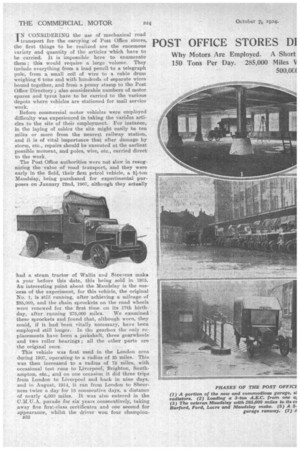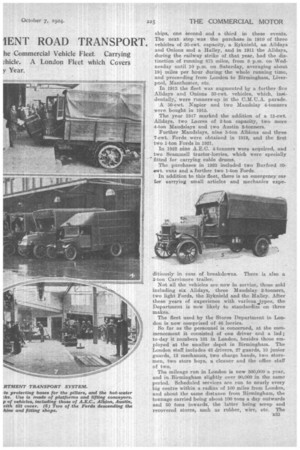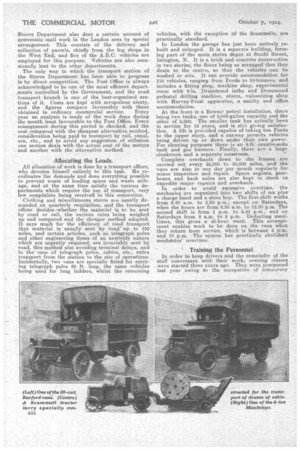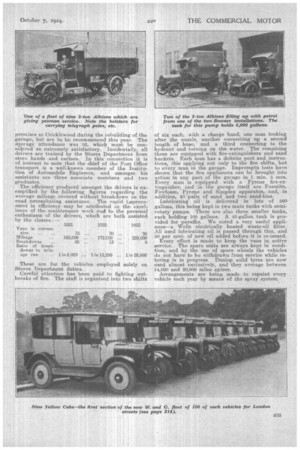POST OFFICE STORES DI 1ENT ROAD TRANSPORT.
Page 14

Page 15

Page 16

Page 17

If you've noticed an error in this article please click here to report it so we can fix it.
TN CONSIDERING the use of mechanical road 1 transport for the carrying of Post Office stores, the first things to be realized are the enormous variety and quantity of the articles which have to be carried. It is impossible here to enumerate them ; this would require a large volume. They include everything from a lead pencil to a telegraph pole, from a small coil of wire to a cable drum weighing 6 tons and with hundreds of separate wires bound together, and from a penny stamp to the Post Office Directory ; also considerable numbers of motor spares and tyres have to be carried to the various depots where vehicles are stationed for mail service work.
Before commercial motor vehicles were employed difficulty was experienced in taking the variclus articles to the site of their employment. For instance, in the laying a cables the site might easily be ten miles or more from the nearest railway station, and it is of vital importance that after damage by storm, etc., repairs should be executed at the earliest possible moment, and poles, wire, etc., carried direct to the work.
The Post Office authorities were not slow in recognizing the value of road transport, and they were early in the field, their first petrol vehicle, a 21-ton Maudslay, being purchased for experimental purposes on January 22nd, 1907, although they actually had a steam tractor of Wallis and Steevens maka a year before this date, this being sold in 1915. An interesting point about the.Maudslay is the success of the experiment, for this vehicle, the original No. 1, is still running, after achieving a mileage of 285,000, and the chain sprockets on the road wheels were renewed for the first time on its 17th birth day, after running 215,000 miles. We examined these sprockets and found that, although worn, they could, if it had been vitally necessary, have been employed still longer. In the gearbox the only replacements have been a jackshaft, three gearwheels. and two roller bearings ; all the other parts are the original ones.
This vehicle was first used in the London area during 1907, operating to a radius of 25 miles. This was then increased to a radius of 75 miles, with occasional test runs to Liverpool, Brighton, Southampton, etc., and on one occasion it did three trips from London to Liverpool and back in nine days, and in August, 1914, it ran from London to Sheerness twice a day for 18 consecutive days, a distance of nearly 4,000 miles. It was also entered in the C.M.U.A. parade for six years consecutively, taking Away five first-class certificates and one second for appearance, whilst the driver won four champion
B32
ships, one Second and a third in these events. The next step was the purchase in 1910 of three vehicles of 30-cwt. capacity, a Ryknield, an Alldays and Onions and a Halley, and in 1911 the Alldays, during the railway strike of that year, had the distinction of running 875 miles, from 8 p.m. on Wednesday until 10 p.m. on Saturday, averaging about 191 miles per hour during the whole running time, and proceeding from London to Birmingham, Liverpool, Manchester, etc.
In 1913 the fleet was augmented by a further five Alldays and Onions 30-cwt. vehicles, which, ineidentally, were runners-up in the C.M.U.A. parade.
A 30-cwt. Napier and two Maudslay 4-tonners were bought in 1915.
The year 1917 marked the addition of a 15-cwt. Alldays, two Lacres of 2-ton capacity, two more 4-tan Maudslays and two Austin 2-tonners.
Further Maudslays, nine 3-ton Albions and three 7-cwt. Fords were obtained in 1919, and the first two 1-ton Fords in 1921.
In 1922 nine A.E.C. 4-tonners were acquired, and two Scammell tractor-lorries, which were specially fitted for carrying cable drums.
The purchases in 1923 included two Burford 30wt. vans and a further two 1-ton Fords.
In addition to this fleet, there is an emergency car for carrying small articles and mechanics expe ditiously in case of breakdowns. There is also a 3-ton Carrimore trailer.
Not all the vehicles are now in service, those sold including six Alidays, three Maudslay 2-tonners, two light Fords, the Ryknield and the Halley. After these years of experience with various...types, the Department is now likely to standardize on three makes.
The fleet used by the Stores Department in London is now comprised of 46 lorries.
So far as the personnel is concerned, at the commencement it consisted of one driver and a lad ; to-day it numbers 101 in London, besides those employed at the smaller depot in Birmingham. The London staff includes 43 drivers, 27 guards, 10 junior guards, 12 mechanics, two charge hands, two storemen, two store boys, a cleaner and the office staff of two.
The mileage run in London is now 500,000a year, and in Birmingham slightly over 90,000 in the same period. Scheduled services are run to nearly every big centre within a radius of 100 miles from London, and about the same distance from Birmingham, the tonnage carried being about 100 tons a day outwards and 50 tons inwards, the latter being scrap and recovered stores, such as rubber, wire, etc. The
Stores Department also does a certain amount of systematic mail work in the London area by special arrangement. This consists of the delivery and collection of parcels, chiefly from the big shops in the West End, and five of the A.E.C. vehicles are employed for this purpose. Vehicles are also occasionally lent to the other departments.
The only way in which the transport section of the Stores Department has been able to progress is by direct competition. The Post Office is always acknowledged to be one of the most efficient departments controlled by the Government, and the road transport branch is one of the best-organized sections of it. Costs are kept with scrupulous nicety, and the figures compare favourably with those obtained in ordinary commercial service. Every year an analysis is made of the work done during the month least favourable to the Post Office. Every consignment during this period is checked, and the cost compared with the cheapest alternative method, consideration being paid to transport by rail, canal, sea, etc., and to avoid any suggestion of collusion one section deals with the actual cost of the motors and another with the alternative method.
Allocating the Loads.
All allocation of work is done by a transport officer, who devotes himself entirely to this task. He coordinates the demands and does everything possible to prevent waste of loading space and waste mileage, and at the same tune satisfy the various departments which require the use of transport, very few complaints being receivea in this connection.
Clothing and miscellaneous stores are usually demanded on quarterly requisition, and the transport officer decides -whether the material is to be sent by road or rail, the various rates being weighed up and compared and the cheaper method adopted. It says much for the efficiency of road transport that material is usually sent by road up to 100 miles, and certain articles, such as telegraph poles and other engineering items of an unwieldy nature which are urgently required, are invariably sent by road, this method also avoiding terminal delays, and in the case of telegraph poles, cables, etc., extra transport from the station to the site of operations. Incidentally, two vans are specially fitted for carrying telegraph poles 68 ft. long, the same vehicles being used for long ladders, whilst the remaining vehicles, with the exception of the Scarathells, are practically standard.
In London the garage has just been entirely rebuilt and enlarged. It is a separate building, forming part of the main stores depot at Studd Street, Islington, N. It is a brick and concrete construction in two stories, the floors being so arranged that they drain to the centre, so that the vehicles can he washed in situ. It can pro.vide accommodation for 115 vehicles, rangitig from Fords to 10-tonners, and includes a fitting shop, machine shop, experimental room with 6-in. Drummond lathe and Drummond pedestal drilling machine, stores, vulcanizing shop with Harvey-Frost apparatus, a smithy and office accommodation.
At the front is a Bowser petrol installation, there being two tanks, one of 3,000-gallon capacity and the other of 5,000. The smaller tank has actually been in service for 12 years, and is still giving satisfaction. A lift is provided capabie of taking ton Fords to the upper story, and a runway permits vehicles being driven up or down under their own power. For cleaning purposes there is an 8-ft. caustic-soda tank and gas burners. Finally, there are a large cloakroom and a separate rnessroom.
Complete overhauls down to the frames are carried out every 25,000 to 30,000 miles, and the vans are also in one day per month regularly for minor inspection and repair. Spare engines, gearboxes and back axles are also kept in stock to expedite major repairs and overhauls.
In order to avoid excessive overtime, the mechanics are organized into two shifts of six plus‘ a charge hand and a store boy. The first shift works from 6.30 a.m. to 3.30 p.m., except on Saturdays, when the hours are from 6.30 a.m. to 12.30 p.m. The second shift is from 1 p.m. to 9.45 p.m., and on Saturdays from 8 a.m. to 2 p.m. Deducting meal'times, this gives a 48-hour week. This arrangement enables work to be done on the vans when they return from service, which is between 5 p.m. and 10 p.m. The system has practically abolished mechanics' overtime.
1 Training the Personnel.
In order to keep drivers and the remainder of the staff conversant with their work, evening classes were started three years ago. They were postponed last year owing .to the occupation of temporary
premises at Crickle wood during the rebuilding of the garage, but are to be recommenced this year. The ayerage attendance was 52, which must be considered as extremely satisfactory. Incidentally, all drivers are trained by the Stores Department from store hands and carmen. In this connection it is of interest to note that the chief of the Post Office transport is a well-known member of the Institution of Automobile .Engineers, and amongst his assistants are three associate members and two graduates.
The efficiency produced amongst the drivers is exemplified by the following figures regarding the average mileage .covered without breakdown on the road necessitating assistance. The rapid aprove-; ment in efficiencymay be attributed to the excellence of the maintenance work arid to the personal enthusiasm of the drivers, whieh are both assisted by the classes :—
These are for the vehicles employed solely on Stores Department duties.
Careful attention has been paid to fighting outbreaks of fire. The staff is organized into two shifts
of six each, with a charge hand, one man looking after the nozzle, another connecting up a second. length of hose, and a third connecting to the hydrant and turning on the water. The remaining three are equipped with fire-extinguishers and sand buckets. Each man has a definite post and instructions, this applying not only to the fire shifts, but to every man in the garage. Impromptu tests have shown that the fire appliances can be brought into • action in any part of the garage in 1 min. 5 secs. Every man is equipped with a Pyrene fire-extinguisher, and in the garage itself are Foamite, Fire foam, Pyrene and Simplex apparatus,, and, in addition, 40 pails of sand and two sand-bins. Lubricating oil is delivered in lots of 300 gallons, this being kept in two main tanks with semirotary pumps. There are also three -smaller tanks, each holding 100 gallons. A 40 %gallon tank is provided for paraffin. We noted a very useful appliance—a -1,17.ells electrically heated waste-oil filter. All used lubricating oil is passed through this, and 50per cent, of new oil added before it is re-issued. Every effort is made to keep the vans in active service. The spare units are always kept in condition, and by the use of spare wheels the vehicles do not have to be withdrawn from service while retyring is in progress. Dunlop solid tyres are now used almost exclusively, and they average between 14,000 and 20,400 miles apiece. Arrangements are being made to repaint every vehicle each year by means of the spray system.






























